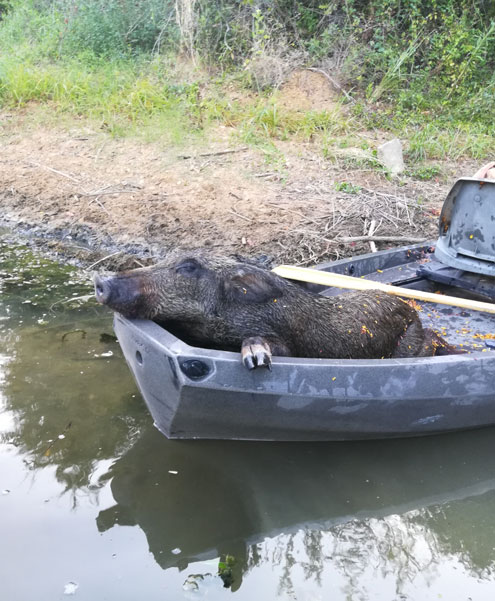To me, a hunting trip has not ended until the meat is wrapped and in the freezer or, as was the case just yesterday, in the skillet! You’ve read my articles long enough to learn that my “loaded” opening sentence will eventually lead to the tale of a recent successful hunt and, probably a recipe! So, here we go!
I have a couple of corn feeders near my home throwing corn about an hour before dark every evening. The trail cameras I have placed on each spot have evidenced hogs, but the time stamp on the photos indicate they are showing up in the middle of the night or very early in the morning, way before this old hunter wishes to be out hunting!
In the past couple weeks, I “set” on each of these spots for an hour or so after dark, hoping the porkers would get eventually come in for an early snack, but no luck and no hogs. Totally unwilling to set up half the night in quest of fresh pork chops from the wild, I decided to make another plan; I’d put my hunting and sign reading skills to work and take the hunt to the hogs! On almost every trail camera photo, I noted the bottom portion of the hogs was wet, only the top of their backs were dry. I began devising a plan.
The porkers were obviously spending much of their time in the water; the logical thing for hogs to do in the heat of the summer. The nearest water source was a long gravel pit about 400 yards from the feeder. I did a bit of exploring and discovered the trail the hogs used leaving the feeder. There were little bits of mud and rubbings on several trees. On close scrutiny, the trail was pretty obvious and easy to follow. It took a straight course through the woods to a deeply rutted trail on the top of the bank of the water source. The water level was low and it was a good 10 feet from the top bank to the water’s edge. The mud along the shoreline literally looked like a hog pen. Tracks were everywhere and several mud wallows a good 3 feet deep outlined the shoreline. I had found WILD HOG CENTRAL, the epicenter of wild pork!
I backed out quietly and made plans to be there at daylight the next day (yesterday) with my lightweight little .223 rifle. My plan was to edge along slowly at first light, use binoculars to glass the shoreline ahead and attempt to locate the sounder of hogs.
If I’m going to have enough space for the promised recipe, I’ll have to hurry this story along! The next morning, I positioned myself at the spot where the hog trail dropped down at the high bank. I could hear splashing and squealing around a bend in the slough. This was going to be too easy, I thought as I stalked quietly to the edge of the brush where I hoped to get a shot.
As luck would have it, all the hogs, about 20 of them, were on my side of the water but they must have gotten my scent; about half of them hightailed it out of sight, but a couple of them hit the water and swam to the other side. I waited until a fat 75-pound sow hit the opposite bank and made the shot. My pork was on the ground, but there was 60 yards of water between the hog and myself. I had a small kayak stashed not far from the spot, but no paddle. A 15 minute round trip back home to get the paddle and I was on my way in the little craft to retrieve my meat!
I found some clear water about 2 feet deep and did my butchering chores right there. I was home in 30 minutes and put on the finishing touches, cleaning up and packaging the fresh pork. I cubed the meat from a front shoulder for guisado, one of my all-time favorite Mexican dishes.
My wife always asks me why I often put fresh meat from the wild to use immediately and I kid her that I consider that part of a successful hunt! I broke out my big 14 inch cast iron skillet, poured a little cooking oil in and tossed in the cubed shoulder meat.
Next went a couple of chopped jalapenos, a handful of fresh chopped garlic, one big yellow onion, a couple stalks of celery, powdered cumin, salt and just a touch of chili pepper.
Then I added a quart of my canned tomatoes. With the fire on low, I let the ingredients simmer for an hour, stirring occasionally and adding a bit of water about halfway through the cooking process. Guisado, if you haven’t tried it, is a thick Mexican dish that can either be eaten as a soup or, as I prefer, allow the liquid to reduce and be served on hot flour tortillas.
Within 3 hours of the harvest of this good eating little hog, I was dining on freshly made guisado made from some VERY fresh wild pork. My wife still doesn’t understand my desire to use the rewards of my hunts immediately and I’m not sure I do either. It might have something to do with the great times I’ve spent at hunting camps where fresh game meat is always eagerly awaited.
I think I might just put those little hams in some cure and transform them into cured, smoked ham! It only takes 6 days for them to become cured meat and a few hours in the smoker to transform the meat into, SMOKED ham! Yep, I do enjoy the total experience of hunting; everything from the scouting to the eating!

Listen to “Outdoors with Luke Clayton and Friends” weekends on radio stations from Nebraska to Texas or anytime online at www.catfishradio.org.